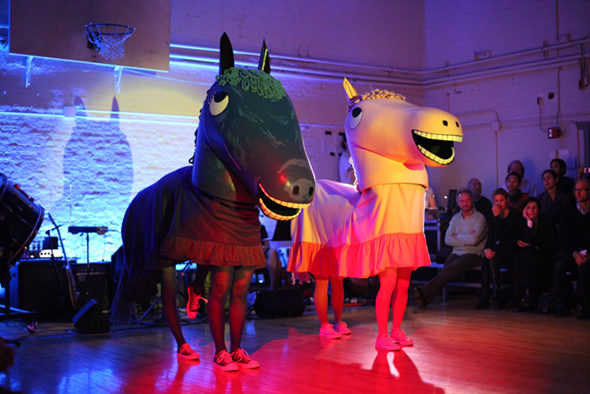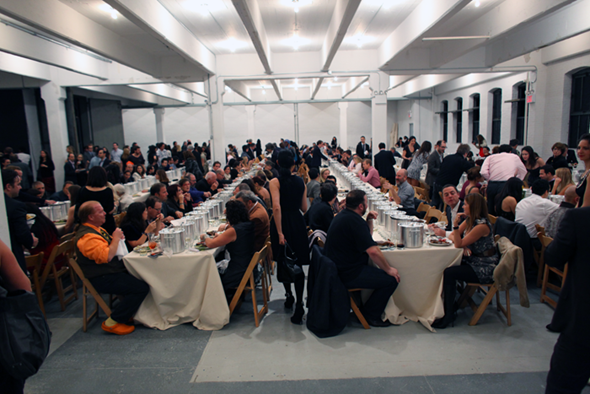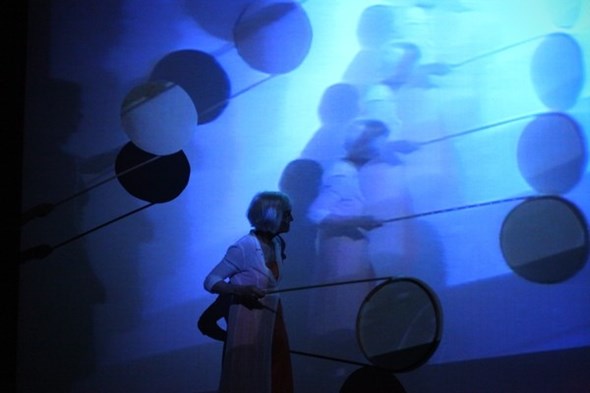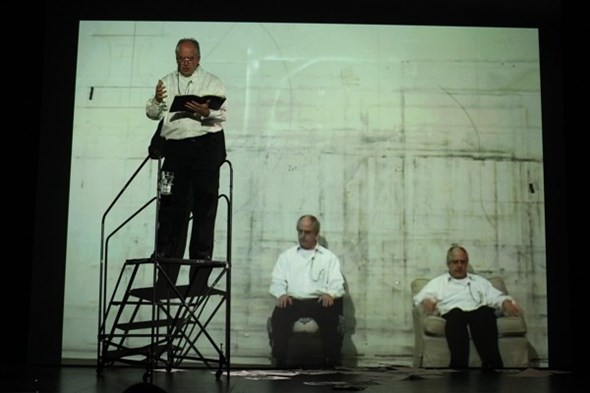
Performa makes all of New York City a stage this November. By ADAM E. MENDELSOHN
November in New York City was a stage for parading, pageantry, the carnivalesque, and marching in the streets. The day after the boozy gluttony of color and street reveling that is Halloween (the city’s biggest and most debauched holiday) saw the opening of Performa 09, the third edition of the biennial, which was appropriately launched on marathon Sunday by artist Arto Lindsay’s amusing, slightly sinister street performance Somewhere I Read in Times Square. The official launch, of course, was the benefit dinner Creation held at X (the old DIA space in Chelsea) devised by Jennifer Rubell. Here, guests were treated to a deconstructivist, participatory feast that involved literally tons of each food group dumped and displayed on white boxes like art. There was a mountain of peanuts on the floor, a huge pile of spare ribs on a plinth, felled apple trees with apples still on them, mountains of ice and sugar, and for dessert, seven chocolate Jeff Koons bunnies that guests were invited to smash with hammers. A fitting, decadent start to what was to follow.
The schedule, including some 150 performances/lectures/installations/screenings/concerts and uncategorizable happenings was as exhilarating as it was exhausting. Held at venues all over the city it was simply impossible to see everything. Encountering oddities on the street was part of the fun and part of the point; that the whole city became a stage and whether something was an official part of the biennale or not activated latent curiosities – was that astronaut I saw walking around the street part of Performa or was it just a regular member of the public? (Alicia Framis’ Lost Astronaut). Tracey Emin and Malcolm McLaren gave talks, William Kentridge and Joan Jonas mounted seminal performances. There was work presented in a variety of media: TV broadcasts, radio broadcasts, and a newspaper published over the course of the biennale by Dexter Sinister. Lesser-known artists contributed sometimes embarrassing, sometimes critical, work and this demonstrated the vitality and relevance of Performa – Erratic Anthropologies, a trio of performances by Guy Benfield, Shana Moulton, and Rancourt/Yatsuk, was a particularly good discovery. I can think of no other platform, at least in America, that encourages artists working across disciplines to take risks and experiment outside their market confined oeuvre. Two pieces which exemplified the pro-risk approach were New York, New York by Candice Breitz and K85 by Dominique Gonzalez-Foerster and Ari Benjamin Meyers. Both pieces employed substantial conceptual strategies that could only function on the night of the performance rather than in rehearsal, which is why the former failed and the latter succeeded, success in this case being a roll of the dice. K85 was a piece of theatre that became a live operations center where 20 or so unsuspecting participants were placed at various locations across the city that corresponded to locations in Martin Scorcese’s film about downtown NYC, After Hours (1985). By way of live feed, radio mikes, cell-phones and stage managers, the participants, known as the »k’s« were picked up by taxis (who were listed in the credits as actors) and brought through the back of the theatre where we witnessed their confusion as they traversed the stage to join the audience. Mixed into this was dialogue from the movies After Hours and Orson Welles’ The Trial (1962), a live orchestra, magic, and drinking club up on the stage after the performance. It was the type of theatre/ performance that keeps you guessing as to what’s happening and allows one to connect the dots and see its rigorous conceptual design a few days later.
What was also particularly successful about Performa was its programming. Many spaces were utilized to maximum potential, such as the Gramercy Arts Club where artist Terence Koh gave a lecture. The club, a stately old national gem, has an artistic membership where the average age is 65. A component of Koh’s lecture was to assemble the audience in the club to mingle, drink gallons of absinthe, eat weird Thai-style black eggs, chocolates with ants in them, and tomato soup out of the can. An hour into mingling and it became clear that the mingling was part of the performance – a site where two aspects of the art world (partly generational, partly political) observed each other. I actually missed the lecture itself because the »mingling« lasted too long and I was booked to go see the mind-blowing, shamanic rumpus about strange American teen-age rituals and angst that was Mike Kelley’s Day Is Done – a culmination of three years of work and the second installment of the exhibition held at Gagosian in 2005. There should be high praise for RoseLee Goldberg and her team for delivering an outstanding biennale that was both celebration and serious discourse. The fact that Performa is a not-for-profit organization proves that good things happen and that the arts can still thrive during economic crisis. Perhaps the final word should go to the biennial itself, which used Filippo Tommaso Marinetti’s declaration to close: »Let us leave good sense behind like a hideous husk and let us hurl ourselves, like fruit spiced with pride, into the immense mouth and breast of the world!«
ADAM E. MENDELSOHN is an artist and critic living in Brooklyn, NY.

Courtesy of Performa, Photo Paula Court

Courtesy of Performa, Photo: Paula Court

Courtesy of performa, Photo: Paula Court
